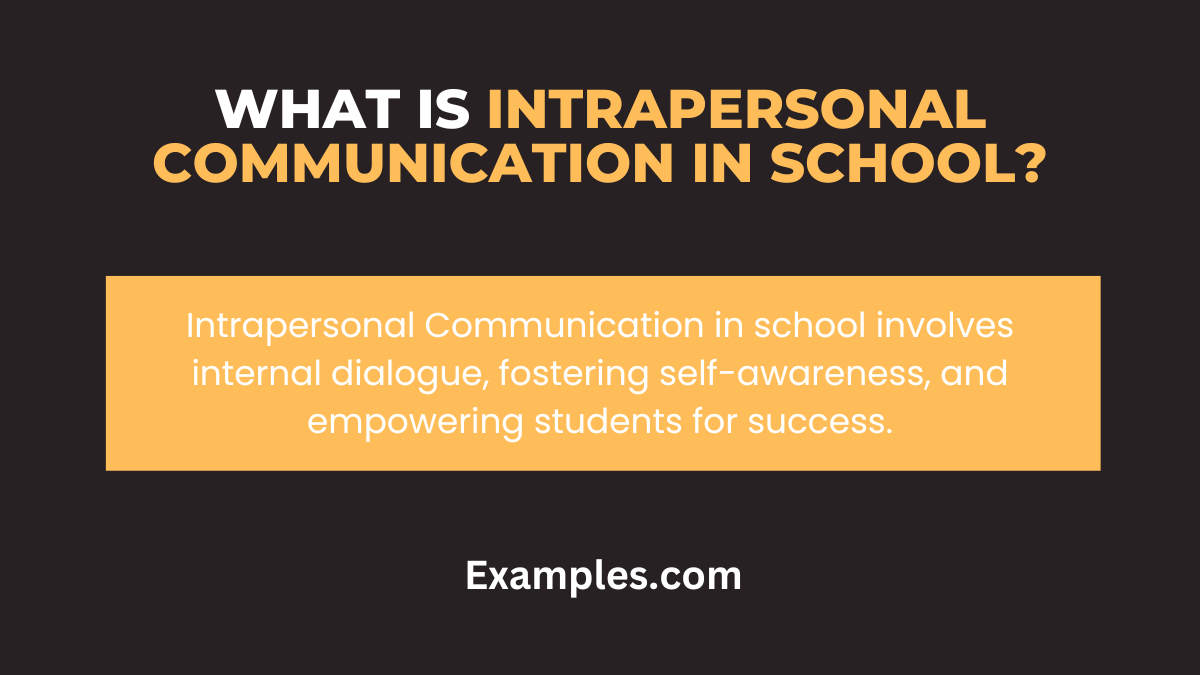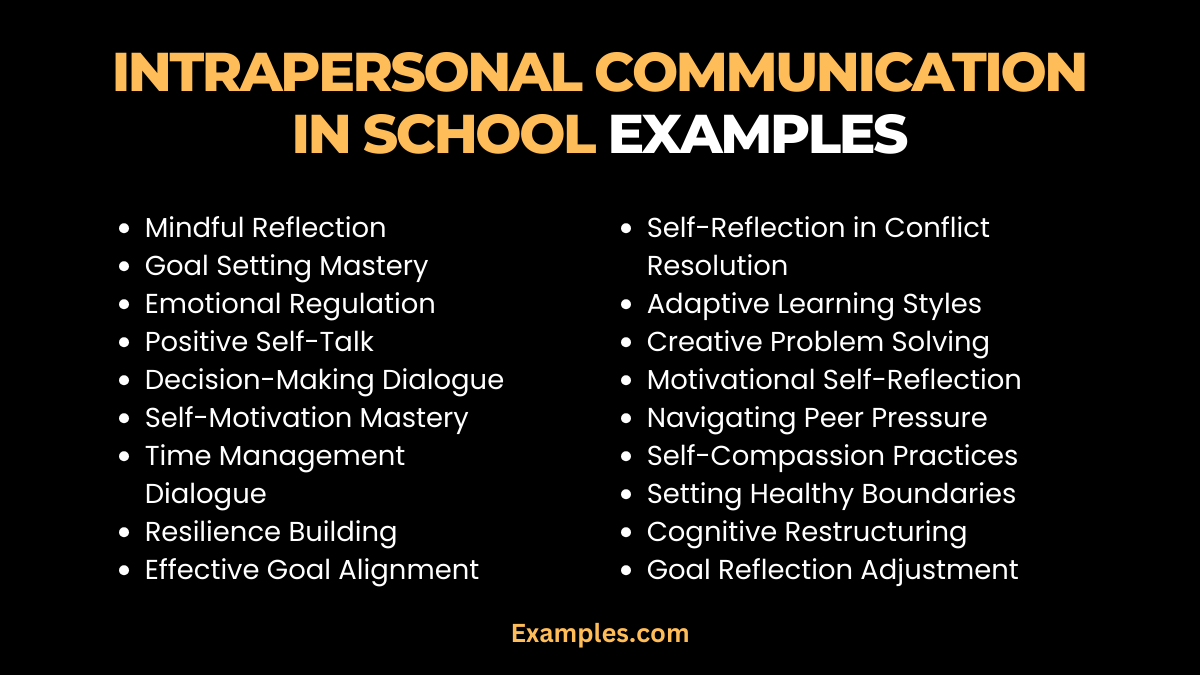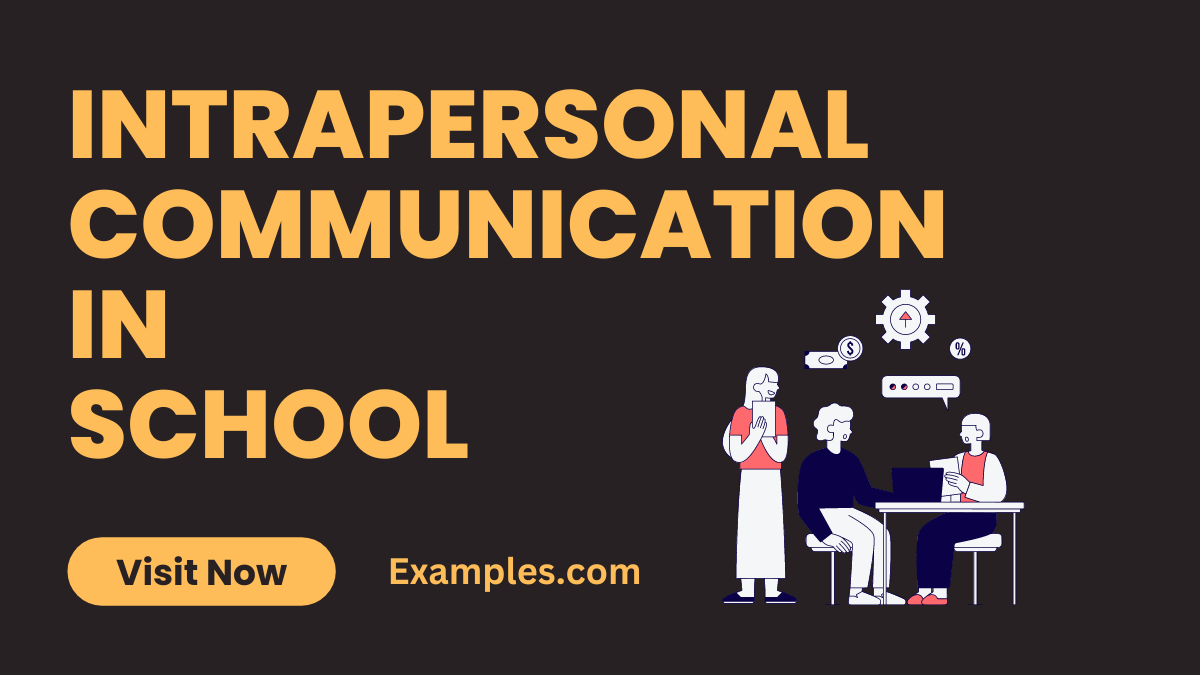19+ Intrapersonal Communication in School Examples
Embark on a transformative journey through our complete guide to Intrapersonal Communication in School. This comprehensive resource not only delves into the core principles but also provides illuminating Communication Examples that empower students to navigate school life with self-awareness and interpersonal finesse. Elevate the educational experience by mastering the art of Intrapersonal Communication, fostering meaningful connections and personal growth. Explore practical insights and proven strategies for effective communication within the school environment.
What is Intrapersonal Communication in School?

Intrapersonal Communication in School refers to the internal dialogue and self-reflection that students engage in to understand their thoughts, emotions, and behaviors. It’s the silent conversation one has with oneself, influencing personal growth and well-being. In simple terms, it’s the way students communicate with their own thoughts and feelings, playing a pivotal role in self-awareness and emotional intelligence. This internal dialogue shapes how students perceive and respond to the world around them within the school environment.
What is the Best Example of Intrapersonal Communication in School?

One compelling example of Intrapersonal Communication in School involves a student facing an academic challenge. In this scenario, the student engages in self-reflection to understand their strengths, weaknesses, and emotional responses. Through internal dialogue, they identify effective study strategies, set realistic goals, and manage performance anxiety. This example showcases how Intrapersonal Communication empowers students to navigate academic hurdles, fostering resilience, self-motivation, and a proactive approach to learning within the school environment.
20 Intrapersonal Communication in School Examples

Explore Intrapersonal Communication in School Examples that illuminate the power of self-awareness and emotional intelligence. Uncover effective strategies for students to navigate challenges, fostering personal growth within the school environment.
- Mindful Reflection: In moments of stress, students practice mindful self-reflection to understand their emotions, promoting calm decision-making.
- Goal Setting Mastery: Through internal dialogue, students set and achieve realistic academic goals, enhancing motivation and focus.
- Emotional Regulation: Navigating social dynamics, students employ Intrapersonal Communication to manage emotions and respond thoughtfully to peers.
- Positive Self-Talk: Students cultivate a positive mindset through affirming self-talk, boosting confidence and resilience in challenging situations.
- Decision-Making Dialogue: In facing dilemmas, students engage in internal discussions to weigh pros and cons, honing their decision-making abilities.
- Self-Motivation Mastery: Internal motivation becomes a driving force as students inspire themselves to excel academically and pursue personal goals.
- Time Management Dialogue: Students use Intrapersonal Communication to plan their schedules, optimizing time for academics, extracurriculars, and self-care.
- Resilience Building: In the face of setbacks, students employ self-reflection to build resilience, learning from challenges and adapting for future success.
- Effective Goal Alignment: Aligning personal values with academic goals, students ensure their pursuits resonate with their inner aspirations and values.
- Stress Coping Strategies: Students utilize Intrapersonal Communication to identify and implement effective stress coping mechanisms, promoting emotional well-being.
- Self-Reflection in Conflict Resolution: During conflicts, students engage in self-reflection to understand their emotions, facilitating constructive and empathetic communication.
- Adaptive Learning Styles: Through internal dialogue, students discover their optimal learning styles, enhancing academic performance and comprehension
- Creative Problem Solving: Students leverage Intrapersonal Communication to think creatively and devise innovative solutions to academic and interpersonal challenges.
- Motivational Self-Reflection: In moments of self-doubt, students engage in motivational self-reflection to reignite their passion for learning and personal growth.
- Navigating Peer Pressure: Internal dialogue helps students establish boundaries, resist negative peer pressure, and make choices aligned with their values
- Self-Compassion Practices: Students cultivate self-compassion through internal dialogue, fostering a positive self-image and resilience in the face of challenges.
- Setting Healthy Boundaries: Intrapersonal Communication aids students in recognizing and establishing healthy boundaries, enhancing positive relationships within the school community.
- Cognitive Restructuring: Students use internal dialogue to reframe negative thoughts, promoting a more optimistic and constructive approach to academic and personal challenges
- Goal Reflectio Adjustment: Students engage in Intrapersonal Communication to regularly reflect on and adjust their academic and personal goals, ensuring alignment with evolving aspirations.
- Celebrating Personal Achievements: Internal dialogue helps students recognize and celebrate their achievements, fostering a positive mindset and self-appreciation.
Roles of Intrapersonal Communication in School
Uncover the pivotal roles that Intrapersonal Communication plays in shaping a dynamic educational experience. From self-regulation to goal-setting, explore the multifaceted contributions that internal dialogue offers to students within the school environment.
- Emotional Navigator: Intrapersonal Communication acts as an emotional compass, guiding students to understand and manage their emotions effectively in various school situations.
- Decision-Making Ally: Students employ internal dialogue to weigh options, make informed decisions, and navigate academic and interpersonal choices with confidence.
- Self-Motivation Catalyst: Internal dialogue becomes a powerful force, propelling students toward academic excellence and personal growth through sustained self-motivation.
Skills of Intrapersonal Communication in School
Unveil the essential skills that define Intrapersonal Communication in the school context. From self-reflection to resilience-building, explore the key abilities that empower students to navigate the intricate landscape of their educational journey.
- Emotional Intelligence Mastery: Students hone emotional intelligence through Intrapersonal Communication, facilitating understanding and positive management of their own and others’ emotions.
- Adaptive Decision-Making: Intrapersonal Communication skills aid students in adapting decisions based on changing circumstances, fostering flexibility and effective problem-solving.
- Strategic Goal Alignment: Students utilize Intrapersonal Communication skills to align personal values with academic goals, ensuring meaningful pursuits and sustained motivation.
Why is Intrapersonal Communication Important for Students?
Intrapersonal Communication is pivotal in student development, offering a multifaceted impact in the school setting.
- Reflection and Self-Awareness: Enables understanding of thoughts, emotions, fostering growth, resilience, and adaptability.
- Empowering Decision-Making: Guides informed choices in academics, peer interactions, and challenges.
- Enhanced Emotional Intelligence: Develops recognition, understanding, and effective management of emotions.
- Goal Setting and Motivation: Aligns personal aspirations, fostering sustained motivation and proactive learning.
- Stress Management: Aids in identifying stressors, implementing coping strategies, and maintaining overall well-being.
- Positive Self-Talk: Cultivates a healthy self-image and builds confidence, especially during academic challenges.
- Individualized Learning Styles: Allows exploration and understanding of unique learning styles, enhancing academic performance.
- Resilience and Adaptability: Encourages learning from setbacks, cultivating adaptability and resilience.
- Effective Peer Communication: Develops internal communication skills, facilitating more constructive interactions with peers.
- Personal Growth and Lifelong Learning: Acts as a catalyst for continuous personal growth and a mindset for lifelong learning, preparing students for future success.
In conclusion, Intrapersonal Communication in school emerges as a powerful catalyst for student growth and success. Through internal reflection, empowered decision-making, and enhanced emotional intelligence, students navigate challenges with resilience. The examples provided offer a practical guide, showcasing the transformative impact of this communication style. This complete guide illuminates the path toward fostering personal development and meaningful connections within the educational journey.



